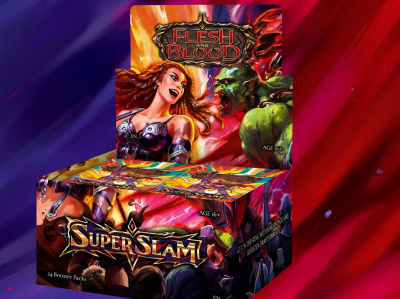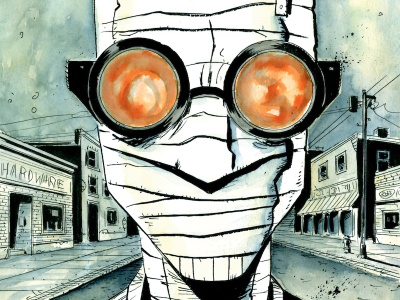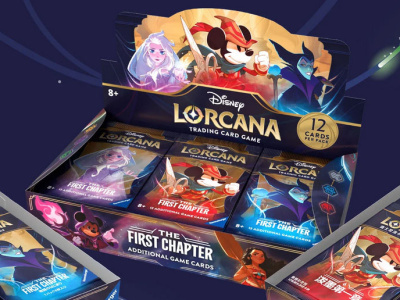At the GAMA Trade Show, ICv2 spoke with Paizo Publisher Erik Mona about Pathfinder sales and the RPG market given the impact that a new edition of Dungeons & Dragons brought to the category, the upcoming slate of new releases for the Pathfinder RPG and Adventure Card Game, and improvements to the company’s website for retailers.
How did your year finish off?
Really positively. We had a successful Pathfinder Adventure Card Game launch with Skull & Shackles. We had a number of hardcover books on the RPG line. Our organized play continues to grow. We launched organized play for the [Pathfinder Society] Adventure Card Guild. 2014 was a strong year for us.
Was it an up year?
Yes, it was an up year from the year before. Absolutely.
Are you seeing any impact from the D&D launch last year?
Not really. What I’ve been hearing anecdotally from a lot of the retailers, especially at some of the presentations that we’ve done here, is that it seems to kind of invigorated the category. ICv2 had that a couple of months ago (see “Six Straight Growth Years in Hobby Games” or “Another Strong Season for Game Sales”). I’m sure that some people who used to play Pathfinder are now playing 5th Edition but we’ve been picking up new people as well so we’re not seeing deleterious drops in our sales.
And the size of your community, is that continuing to grow?
The size of our community continues to grow, yeah, depending on how one measures community. Every metric I have, it continues to grow. We’ve got more registered players in Pathfinder Society than we’ve ever had. We have more members of the Paizo.com community than we’ve ever had. I think one of the things that Pathfinder does in the new post-5th Edition paradigm is, it’s a mature brand, it’s got multiple monthly releases. There’s product for stores to sell.
That’s a huge difference in release strategy.
Yeah, so people seem to like the new D&D; it’s getting positive reviews. We have not yet seen a significant amount of that meaning that people are no longer playing Pathfinder, at least by the metrics that I have. I’m sure that’s happened, but we’re not seeing in a way that’s causing me to freak out.
Retailers, in general, have told us that there has been no drop-off in Pathfinder sales. Some people play them both.
Exactly, and if we can have an RPG market where people are maybe a little less partisan and are willing to try a bunch of different games then that’s good for the whole industry.
People are talking about more than two games now.
You can’t really have a category with just one or two games. I’ve heard that from some of our mass market accounts. I’ve heard that from a lot of the retailers here that seems to be lifting a lot of the boats in the RPG category, which is great.
What long-term trends are you seeing in the audience for RPGs?
I joined the industry as a professional in ’99, and started going to cons and stuff in ’95. I remember very vividly from about ’95 until relatively recently, maybe the last 10 years, there’s been a lot of concern in the RPG publishing industry about the graying of the hobby. Are we aging ourselves out of the game?
One of the things that is a great antidote to that kind of worry is what’s happening on the convention level. I go to a show like PAX Prime, for example, in our backyard in Seattle, and it’s primarily a videogame show. Most people are going for the videogames, particularly the younger crowd. They’ll get dropped off by their parents, they’ll go to the videogame hall, they’ll blaze through the videogame hall, which you can do in about three hours if you’re not going to stand in line for some demo or something. They’re there the whole weekend and have nothing else to do, so what do they do? They come down and explore the tabletop areas.
When I was growing up it was ‘I’m an RPGer. I’m a war gamer. I’m a video gamer.’ I think the new generation doesn’t differentiate like that. They’re just like, ‘Oh, a game? Cool, let’s play.’ That’s really good. Demographics are really in our favor in this business these days.
What do you have planned for this year?
This year we’re doing a couple of things on the Adventure Card Game front. We’re going to do another campaign. We’re doing Wrath of the Righteous, which has been one of our more popular Adventure Paths. It’s a sword and sorcery, heroes vs. demons kind of adventure (see “'Pathfinder Adventure Card Game: Wrath of the Righteous'”). Skull & Shackles, which was the Adventure Path that we did last year for the Adventure Card Game, was a pirate Adventure Path. And Rise of the Rune Lords before that was kind of a mainline fantasy. This is a return to mainline fantasy, which I think is going to be good. Pirates was a departure but I think heading back to the main fantasy is really the strength of the Pathfinder brand and is in line with a lot of what the audience is telling us they want, so that’s always good.
When does that launch?
May. We’re trying to find out what the right pace for these things is.
You had been doing one a year, so this will pick up that pace?
A little bit, yeah. We’re currently thinking a little more often than once a year but not twice a year every year. We’re trying to listen to what retailers are telling us and look at the sales numbers and trying to figure out what the right cadence of release is, but the next one’s May for Wrath of the Righteous.
Then there’s monthly Adventure Packs that go along with that, and we’re also doing character decks that tie into the Adventure Card Guild organized play program. You need a character deck to play and a lot of people just like to supplement their Rise of the Rune Lords or Skulls & Shackles games with different characters. It’s a nice way to get more value out of the base set. So that’s what’s going on with the Card Guild and Card Game.
With the RPG we’ve got a lot of things coming out. The Strategy Guide is finally coming out. This is a book that was originally supposed to come out last year but when we got it back from the printer all the pages were stuck together so we had to reprint it. That’s finally out this month. That’s a companion to the Core Rule Book, it’s aimed at explaining the rules and making it easy to get into (see “'Pathfinder' 2014 Releases”).
When we put out the Core Rule Book in 2009 it was very much a preaching to the choir sort of book, it was aimed at hobby lifestyle gamers. What happened in the past several years is all of the sudden we started hearing from quite a lot of people that Pathfinder is the first game. They don’t come to it from D&D, or from a different game. They go to their store and get introduced to Pathfinder, so we started to feel a responsibility to really make an easy entry point to the game. The first step to that was the Beginner Box that we did a couple of years ago (see “New Version of 'Pathfinder Beginner Box'”). That’s been very, very popular. It’s gone through several printings and continues to sell well for us, but we wanted to ease that transition into the full game so the Strategy Guide is heavily illustrated, lots of examples, lots of step-by-step character creation advice and really is the companion piece to the Core Rule Book. If you have someone trying to join your Pathfinder game, you say ‘Read the Strategy Guide’, which is 128 pages instead of 576 pages. You need both in order to make your character and play the game, but a lot of people will be able to glean how the games works from the Strategy Guide so that’s an important piece of the puzzle strategically, and I’m glad to have that coming out this year.
We’re also doing in April a book called Pathfinder Unchained, which is sort of the opposite of that (see “'Pathfinder Unchained'”). It’s a treasure trove of optional rules letting the Pathfinder RPG design team loose to do whatever they want, damn the consequences. Here’s an alternate version of combat; here’s a different way to increase your character’s level, really a lot of experimental stuff that players can pick and choose what they want to implement. So maybe you like Pathfinder but you feel it takes too long to make encounters or make monsters, there’s a streamlined version of how to do that in this book.
There’s also revisions on four classes so there’s a revised rogue, revised monk, and a revised barbarian. Now that we’ve done almost 30 classes and we’ve got several years behind us and people think in retrospect, maybe the rogue and the monk are not powerful enough vs. some of the stuff that’s come since, so we’ve retuned those classes and given people an optional version if that’s a concern of theirs. Also the summoner, which is a class that we put out in the Advanced Player’s Guide, very, very powerful class, perhaps even unintentionally so, this is a new version of that brings its power in line with everything else. So that’s a big, huge trove of optional rules, cool alternative takes on different things that people can add to their game.
In late July/August (I say that because it’s a Gen Con release and Gen Con straddles both months this year), is Occult Adventures and that’s the big, major Pathfinder release for this year (see “'Pathfinder: Occult Adventures'”). It’s our answer to Psionics. It’s a lot of mental magic, a lot of spirits, a lot of ghosts, forbidden knowledge, all that kind of stuff.
Traditionally in fantasy roleplaying psionics and psychic magic has been sort of bolted onto a whole other rule system you have to learn on top of the rule system. That’s always been the way with D&D for example. With Occult Adventures, we’re taking the way that spells work in Pathfinder, the rules people already know, and mapping the conceptual stuff like psychic combat on the astral plane or astral projection and things like that onto the existing spell structure. One of the things that’s cool about that is while we’re still using the framework of how spellcasting works in Pathfinder, we’re doing some really interesting and unique mechanical things with these classes.
I’m really excited about our Occult Adventures because it’s got a lot of new to it. If you think back to the books I’ve just outlined, for example, the Unchained book has got four classes that are revisions of existing classes. Strategy Guide doesn’t have any classes at all but it’s very much like ‘here’s how you use this book that already exists.’ Last year’s big release was the Advanced Class Guide. It had 10 new classes in it, but each one of those was an amalgamation of two existing classes so you’d take like a barbarian and a bard, smoosh them together and you’ve have a skald. There’s some interesting new rules to it but fundamentally its multi-class barbarian and a bard.
With the six classes that we’re introducing in Occult Adventures they are still six legitimately, totally new things, they are not revisions of anything. They are full on new frontier game design and some conceptual things that we’ve never done in the game. We’ve never had a psychic in the game, for example. We’ve never had a character who can summon spirits and have the spirits inhabit their body and gain powers from them like the medium can do. So there’s the medium, there’s the mesmerist, who’s sort of a reverse bard. The bard buffs up his party and the mesmerist de-buffs his enemies, who is about mind control and things like that. We’ve got the kineticist who choses an energy type and does not have spells but can manipulate that energy in terms of shapes and do different things with it. That’s a totally different style of magic than we’ve ever done in Pathfinder before.
We did extensive play testing last year, people really responded positively, especially to the kineticist. Very different and people really liked what they saw. We’ve also have the spiritualist who has a ghost buddy who helps her out, and we’ve got the occultist who all about exploring old legends and lost artifacts and things, and gleaning powers and information from that.
That’s the big hardcover for the year. $39.99 and 272 pages or so.
What’s going on with Adventure Paths?
We do two a year so the one that we’re doing now is Giant Slayer (see “February 'Pathfinder' Releases”). Giant Slayer started in February and runs through July. It is a blood and thunder fantasy vs. giants. The nice thing for Giant Slayer for me is, over the last year we did some pretty experimental things with the Adventure Paths. We had Iron Gods, which was like a science fantasy—there’s robots and stuff in there. Before that we did Reign of Winter, where you’re jumping from planet to planet and one of the planets was even 1917 Earth where you fought Rasputin in Russia, because once that idea came out in a brainstorm we couldn’t not do it. But we’re really experimental, and Giant Slayer is straight, mainline fantasy. People have been responding really well to that.
In August we will launch our next Adventure Path, which is called Hell’s Rebels. That is an urban Adventure Path where players take on roles of revolutionaries who are overthrowing the evil, tyrannical leadership of their city. It’s set in a country called Cheliax, which is kind of the big, evil nation. It was formally a giant empire, it went into civil war and the winners of the civil war were these evil spell casters who had bound devils and things like that so it’s a really bad place. Hell’s Rebels is an opportunity for players to overthrow that leadership in one of the cities in that nation. For the last couple of years every time we’ve done polls of Paizo.com fans on what Adventure Path would you like to see, they say ‘we want to see an urban Adventure Path and we want to see a Cheliax adventure’ so this is squeezing both of those ideas in together. There will be tie-in products and things like that as well.
What’s your pace of releases in 2015 vs. 2014?
Pretty similar. If anything, a little bit more. One of the things we announced here that I’m pretty excited about is a line called Flip-Mat Classics. It’s an accessory; basically an 18” x 24” fold-out map with a grid on it. It’s got coating so you can write on it with dry erase/wet erase and it’s scaled for miniatures combat for Pathfinder. We’ve done about 50 different ones over the years. We do a basic one, which is just a grid, but we also do ones that are like a forest, tavern, things like that. Almost every Pathfinder Society organized play scenario that we’ve done uses these maps. We’ve got 199 of those scenarios out as of today since the beginning. A lot of them reference maps that have gone out of print, so Flip-Mat Classics bring eight out-of-print, very popular, very high utility maps like ship, tavern and forest back into print. That will be in addition to the monthly map products that we do, so that’s a little bit more.
Adventure Card Game releases will be about the same. We’ll be doing monthly class decks starting this summer so maybe a couple of more decks there. The hardcover release schedule for Pathfinder RPG is the same in terms of the pace. In fact, because Strategy Guide was supposed to come out last year and has now moved into this month, there’s even one more hardcover than last year.
Anything else that our readers should know that’s happening at Paizo?
One thing that I’m pretty excited about is over the last year we’ve put a tremendous amount of resources into improving the back end on Paizo.com. One of the benefits of that is we have a really good retailer locator at Paizo.com/retailers. Stores can register their store, they can say they’re interested in Pathfinder Adventure Card Guild, for example and then every week we put out a new scenario for the Adventure Card Guild. We fulfill that PDF directly to the retailer for free.
In a couple of months I’m going to be implementing free roleplaying game scenarios, so every month we do two of those. Usually they’re about $5. Up until now we would contact the campaign coordinator; we don’t want stores paying for scenarios—that’s for the general public. If you need a free one, talk to Mike [Brock] and he’ll get it to you. Now we’re making that automatic as well, so all of our organized play collateral will be delivered to registered stores immediately at no charge. That’s something I’m pretty excited about, and I’m trying to get a lot of retailers here to know about that program and to sign up for it.
One of the other things that is cool about this is stores that are registered as being interested in Pathfinder Adventure Card Guild on Paizo.com are also entitled to get a free base set of every Adventure Card Game release as we put them out. If you’re a registered store you just contact our customer service and they’ll send you a free $60 boxed set to use for OP at your store.








